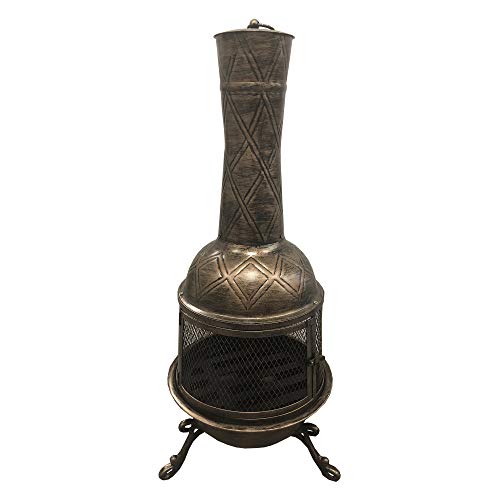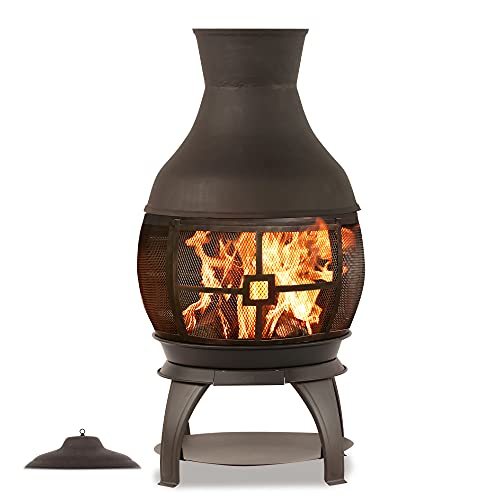Ceramic Chimineas
Ceramic chimineas have a classic, rustic look that can add warmth to any outdoor space. They are also easy to maintain. They are available in various styles, and can even be coated for an appealing appearance.

As with all chimineas, they must be kept away from structures with overhanging, as well as any other structure that could catch on fire. They are also susceptible to damage caused by extreme frost, rain and abrupt temperature changes.
These are made of clay or terracotta
A chimenea is a great addition to any patio or backyard, and can be used to add warmth and atmosphere to any garden event. They are simple to use and can provide a warm fire that is accompanied by a striking chimney. They are available in various sizes and shapes, with many different designs and decorative finishes. Clay chimineas are expensive however their style and durability make them worth it.
Some
chimineas sale are built to cook food, however others are primarily intended for heating purposes. The chimney allows you to control heat and directs smoke upwards, which protects your fire from rain or wind. Certain chimineas include a grill that could be added so that you can cook your favorite dishes on the grill.
Cast iron chimineas are more durable than clay ones and can last for generations if well maintained. The price is higher and they are slightly more difficult to move. They are usually coated with a heat-resistant paint to stop the rusting. Moreover, they tend to become hotter on the outside, so care should be taken when children are present. They are also more likely to crack if exposed to abrupt temperature fluctuations or physical harm.
The potter smoothes the outer and inner surfaces of the clay chiminea before it dries. The clay is then heated to high temperatures and then glazed, if necessary. The resulting chiminea can be subject to changes in temperature and moisture, so it is best to locate a permanent spot for it in the garden and cover it with a chimenea covering when it is not in use.
Before they can be lit, clay chimineas require to be cured.' This is accomplished by putting a layer or river sand at the bottom of the chiminea, and adding small pieces of wood to create a small flame. Once the fire has burnt out, the sand has to be removed and the chiminea may be lit.
They are available in different styles
Chimineas can add a rustic, Southwestern feel to any outdoor area for entertainment. They are effective heaters that can provide a great place to gather with your loved ones. They also offer a fantastic way to create a dramatic display for your garden. These fire places that burn wood are built in a bell-shaped design with a chimney that emits smoke and heat into the air. The chimney also protects the fire from wind and rain. Chimineas can achieve their full-blown burn in about 15 minutes. They also generate plenty of heat. You can use a variety of types of wood to fuel the fire that include aromatic cedar and hickory.
Clay chimineas are the traditional choice but modern versions made of cast iron and copper have become increasingly popular. These chimineas are able to handle higher temperatures than clay chimineas which makes them more flexible and robust. They can also be used for grilling and barbequing and for burning wood. The most modern models have an adjustable grate that makes it easier to control the flames. The chimineas have a lid made of heavy-duty that protects it from the elements and a spigot to pour in water.
Some modern clay chimineas have been extensively grogged in order to stop thermal stresses that can cause traditional earthenware pieces of pottery to crack. However, they're fragile and should be set on a concrete, tiled or stone base to avoid them falling over. They can be used for charcoal, wood, and other sources of heat, but work best with hardwoods such as oak, hickory, and Acai.
When choosing the plants to be placed in the chiminea's surroundings, keep in mind that they should be able to handle heat. They also shouldn't touch the chiminea. Ideally, the plants should be arranged so they create a screen or backdrop for your chiminea. Evergreens like boxwood or holly will add height to your arrangement, while flowers such as lavender or roses can be used to add the color.
Unlike a fire pit, which is open and requires frequent refueling The chimney of a chiminea is able to vent smoke away from the flames, so it's safer to use. It is important to keep flammable materials away from your chiminea, and avoid direct contact with water after it has been heated as this can cause it to crack.
Easy to maintain
The kind of chiminea you choose will be determined by the design you're looking for, the types you have at hand and the reason you plan to use it. Clay is better for the environment and biodegradable while metal ones require more maintenance.
Before cleaning a
ceramic chiminea, it's important to make sure that it is completely cool down. Also, make sure that it's in a safe place where sparks and ash won't fall on anything that is flammable. If you are unsure how to proceed seek out an expert or your local fire department for safety guidance.
To clean a chiminea first clean it thoroughly to get rid of dirt and other debris. Then apply a sponge or brush to get rid of the more difficult stain. Make sure to make use of a non-flammable cleaner, such as bleach or a mild detergent. After you've finished, wash off the chiminea with clean water and allow it to dry completely before reuse.
It's a good idea to add a layer of sand on the chiminea's base after it's been cleaned and dried. This will keep the clay in a stable and cool state. This will allow it to last longer and prevent cracking. Lava rocks are the best choice, but any sand will work. The lava stones add an additional layer of insulation to keep the Chiminea cool. This makes it safer to use.
Sanding the chiminea's surface frequently is the best method to avoid rust. You should not soak it in water, as this could cause cracking. The chiminea can be painted using a rust resistant paint to guard against future corrosion.
If a chiminea isn't in use it must be covered with a waterproof cover for the
chiminea fireplaces. This will allow the chiminea to stand up to snow, rain and also make it more attractive. The cover also helps protect it from rust and other damages caused by direct sunlight. You can purchase a chiminea lid from the local home improvement store or on the internet.
It is safe
Chimineas are extremely safe when used properly. Like all fire apparatuses, chimineas can be dangerous if not maintained. Chimineas are made of clay or metal and should be kept outdoors and away from a fire-prone structure like your home. When using the chiminea, it is essential to keep an eye for it and to not allow it to get too hot. This will prevent the chiminea from cracking or becoming damaged. If you see cracks in the
top rated chiminea's chiminea's surface, use a ceramic caulk such as RTV silicone high temperature caulk. It is designed to withstand high temperatures so it is perfect for this kind of application.
A chiminea can also be damaged by rain, wind and snow. To guard it from the elements, it is best to keep it in an enclosure during winter. Contact the manufacturer if you're unsure of the best way to keep your Chimenea. Chimeneas can be kept in a garage or shed and you can purchase a protective case.
As opposed to regular fireplaces chimineas aren't sealed and therefore provide less control over the flames. They also can release many sparks that are hot because they don't have an impervious seal. If this is the case you can put chicken wire or small holes in fencing around the outside of the stack to contain these sparks. You can make your chiminea more safe by using seasoned chimineas because it will generate less sparks than those that are unseasoned.
Even though a chiminea is easier to use than a firepit, it's still an extremely hot stove that must be kept away from flammable objects like porches or trees roofs. Be sure to keep pets and children out as it can emit sparks or embers which could burn them. A chiminea should also be placed on the hearth of the patio. It is a space that is covered with pavers or other materials that are fire-proof to create a secure zone. Chimineas must be positioned away from eaves or other overhead objects which could catch fire.

 As with all chimineas, they must be kept away from structures with overhanging, as well as any other structure that could catch on fire. They are also susceptible to damage caused by extreme frost, rain and abrupt temperature changes.
As with all chimineas, they must be kept away from structures with overhanging, as well as any other structure that could catch on fire. They are also susceptible to damage caused by extreme frost, rain and abrupt temperature changes.